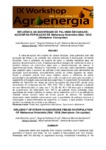Use este identificador para citar ou linkar para este item:
http://www.alice.cnptia.embrapa.br/alice/handle/doc/1035580| Título: | Influência da quantidade de palhada em cana-de-açúcar na população de Mahanarva fimbriolata (Stâl, 1854) (Hemiptera: Cercopidae). |
| Autoria: | DORNELES JUNIOR, J.  ALVES, R. P.   SANTOS, R. M. dos   RAMOS, R.   RAMOS, N. P.   PRADO, S. de S.   |
| Afiliação: | JOAZ DORNELES JUNIOR, FCA-UNESP; ROGERIO PALHARES ALVES, Fazenda Rosário; ROBERVAL MANOEL DOS SANTOS; REBECA RAMOS, PUCCAMP; NILZA PATRICIA RAMOS, CNPMA; SIMONE DE SOUZA PRADO, CNPMA. |
| Ano de publicação: | 2015 |
| Referência: | In: WORKSHOP AGROENERGIA: MATÉRIAS PRIMAS, 9., 2015, Ribeirão Preto. Anais... Ribeirão Preto: APTA: IAC, 2015. RE 088. 7 p. |
| Conteúdo: | Resumo: A cana-de-açúcar tem origem de países tropicais, uma gramínea com alta produção de folhas e de palhada. Seu sistema radicular é fasciculado, formando touceiras. Com a proibição da queima da cana, a colheita mecânica gera um acúmulo de palha sobre o solo. A palhada auxilia a ciclagem de nutrientes no solo, e também fornece um microclima ideal para o desenvolvimento de insetos. A cigarrinha-das-raízes, Mahanarva fimbriolata, é uma das mais importantes pragas que surgiram apos o acumulo de palhada e são responsáveis pelo decréscimo da produção sucro-alcooleira, principalmente devido as ninfas sugarem as raízes. Assim o presente estudo teve como objetivo avaliar a influência de várias porcentagens de palhadas deixadas sob o solo na cultura da cana para se avaliar o surgimento e flutuação populacional das cigarrinhas. O experimento foi realizado em talhões de 10mx30m em áreas da Usina Açucareira de Guaíra/SP, sendo cinco tratamentos (T) compostos por 0%, 25%, 50%, 75% e 100% de palhada e avaliado em seis diferentes dias, ou seja, aos 7, 15, 30, 60, 90 e 120 dias após a instalação do experimento. No tratamento com 100 % de palhada foram coletadas maior quantidade de ninfas e adultos no campo. Já no tratamento com 0 % de palhada foi coletado menor numero tanto de ninfas quanto de adultos. Os resultados observados neste trabalho evidenciaram que a quantidade de palhada favorece a colonização e desenvolvimento da cigarrinha no campo, o qual poderá influenciar também no método de controle a ser utilizado. Abstract: Sugarcane plants are originally from tropical countries, and it produces high quantities of leaves and straw. Its root system is fasciculated and form clumps. Nowadays with the banning of sugarcane burning, mechanical harvesting of the plants will generates an accumulation of straw on the ground. The mulch helps nutrient cycling in the soil, and also provides an ideal microclimate for the development of insects such as the sugarcane spittlebugs, Mahanarva fimbriolata. Mahanarva fimbriolata is one of the most important pests that arose after the accumulation of straw and are responsible for the decrease in sugar and alcohol production, mainly because the nymphs suck the roots. The present study aimed to evaluate the influence of various straws percentages left on the ground to assess information about the emergence and population fluctuation of the splittlebugs. The experiment was conducted in areas of 10mx30m in the Sugarcane Mill of Guaira, Sao Paulo State. Five treatments (T) or percentage of straw were compared and were composed of 0%, 25%, 50%, 75% and 100% of straw. Evaluation happened in six different dates at 7, 15, 30, 60, 90 and 120 days after installation of the experiment. The area with 100% of straw collected higher numbers of nymphs and adults on the field. On the other hand, the treatment with 0% of straw collected much smaller number of nymphs and adults. The results of this study confirm that the higher amount of straw on the ground helped the spittlebug colonization and development, which can also have influence on the control method to be used. |
| Thesagro: | Palhada Mahanarva fimbriolata |
| NAL Thesaurus: | Sugarcane Straw Euryaulax carnifex |
| Palavras-chave: | Cigarrinhas-das-raízes Sugarcane spittlebug Cana-de-açúcar |
| Tipo do material: | Artigo em anais e proceedings |
| Acesso: | openAccess |
| Aparece nas coleções: | Artigo em anais de congresso (CNPMA)  |
Arquivos associados a este item:
| Arquivo | Descrição | Tamanho | Formato | |
|---|---|---|---|---|
| 2015AA026.pdf | 327,07 kB | Adobe PDF |  Visualizar/Abrir |









